This research explores the impact of structural variations in of the laminar derived from seaweed on their immunomodulatory properties. Laminarins from Laminaria digitata, L. hyperborea, and Saccharina latissima, were obtained using a two-step water extraction protocol, followed by structural characterization by FT-IR spectroscopy, 1H NMR, and MALDI-TOF MS. The laminarin backbones were confirmed as β–1,3-linked glucans with species-specific percentages of β–1,6-linkages (~10 %, ~4 %, and ~21 %, respectively). Each polymer chain consists of approximately 24 to 25 monomer units, while oligosaccharide fractions, produced using the enzyme LPHase, displayed distinct DP-ranges, degrees of β–1,6-branching and intrachain linkages. Laminarin from L. hyperborea and specific oligosaccharide fractions from L. hyperborea and S. latissima influenced cytokine secretion by dendritic cells (DCs). L. hyperborea laminarin and the fraction LhF5 (DP5–DP8) stimulated increased IL-6 and IL-10 secretion by DCs, suggesting a dual role in promoting inflammation and regulating the immune response. In contrast, LhF5, LhF4 (DP6–DP10), and S. latissima laminari-oligosaccharide fraction SlF3 (DP6–DP9) caused decreased TNFα secretion, reflecting anti-inflammatory potential. Co-culturing of treated DCs and CD4+ T-cells showed that L. hyperborea laminarin caused increased IL-17 and IL-10 secretion, whereas SlF3 caused reduced IL-12p40 and IFN-γ secretion. These findings show that DC maturation and T-cell activation are affected by of the laminar of certain size-distribution and branching, implying therapeutic potential for the treatment of inflammatory diseases or vaccine enhancement.
Author: Kristín Edda Gylfadóttir
Salmon farming has a low feed conversion ratio and provides high-quality protein with relatively low environmental input. In Iceland, production is currently 45,000 t annually and is projected to reach 245,000 t by 2033, over 30 % of which is expected from land-based systems. This study assessed the potential environmental impacts of land-based Atlantic salmon farming using Life Cycle Assessment (LCA), with a functional unit of 1 t of salmon produced in land-based farms in Iceland in 2021. A hypothetical scenario investigated the avoided environmental burdens of utilizing the salmon manure as fertilizer based solely on its nitrogen, phosphorus, and potassium content, instead of producing synthetic fertilizer. In addition, a sensitivity analysis tested four electricity mix scenarios: the default Ecoinvent Icelandic electricity mix (Scenario 0), an LCA-based Icelandic energy mix (Scenario 1), the residual mix accounting for Guarantees of Origin (GOs) certificates (Scenario 2), and the Ecoinvent European mix (Scenario 3). For Scenario 0, impacts per functional unit were: 1.4 t CO2 eq (Global Warming Potential), 8 kg SO2 eq (Terrestrial Acidification), 0.6 kg P eq (Freshwater Eutrophication), 582 m2a crop eq (Land Use), and 8659 m3 world eq (Water Scarcity Footprint). These results reflect relatively low environmental burdens compared to similar studies in other countries, largely due to Iceland’s renewable energy. However, results from scenario 3 in the sensitivity analysis led to a GWP increase by 377 %, due to its large fossil-based composition. These results stress the importance of energy sourcing in shaping environmental outcomes and can guide impact reduction strategies for future land-based salmon farming in Iceland.
Greenland halibut (Reinhardtius hippoglossoides) is a commercially important species in the North Atlantic whose spatial population structure has not yet been fully determined across its entire range. We genotyped individuals from across the North Atlantic using a subset of informative single nucleotide polymorphic (SNP) markers to assess their usability as a SNP panel. We assessed whether these purportedly structured SNPs had any association with sex. We found several of these loci to be in sex-determining chromosomes and that their inclusion generated genetic structure mainly in males. The population structure without the sex-associated SNPs was weak and followed an isolation-by-distance pattern, likely with a large regional population on each side of the North Atlantic. We discuss how different sex ratios in the samples and/or an evolving sex-determination system in this species likely caused the inclusion of sex-associated loci in the panel. We found suggestive evidence of polymorphisms at sex-determining chromosomes differentiating males on east and west locations, indicating evolution of the sex-determination system. These results highlight the importance of documenting sex-based differences in genetic studies and call for a better understanding of genomic architecture to understand sex-determination systems across the whole distribution of sexually dimorphic species.
Genetic introgression of domesticated plants and animals into wild populations occurs globally. Such introgression disrupts adaptive potential, reduces fitness in wild populations and threatens intraspecific genetic variation. The best-documented case of farmed introgression into wild populations is that of the Atlantic salmon (Salmo salar). Norway is the world’s largest producer of farmed Atlantic salmon, and the industry is growing in Iceland and other countries. In Norway, genetic introgression resulting from farmed escapees breeding with wild conspecifics has been documented in approximately two-thirds of 250 salmon populations studied. This comprehensive quantification has been possible due to a panel of genetic markers diagnostic of farmed introgression. Improved genomic resources, continued selection and genetic drift in the farmed breeding lines, as well as new breeding lines in commercial production, call for an updated tool to quantify farmed genetic introgression. Here, we present second-generation panels of genetic markers diagnostic of farmed introgression in Norway and the first panels of genetic markers diagnostic of farmed introgression in Iceland. We show that these diagnostic markers provide increased power to detect introgression compared to the first-generation panel, as well as increased power compared to a genome-wide marker set. Improved accuracy will benefit the ongoing monitoring of farmed introgression and facilitate research into the ecological and functional effects of farmed introgression in wild populations.
Markmið verkefnisins voru (1) að kanna hvaða áhrif mismunandi kornskammtar, 0%, 21% eða 37% af heildarfóðri fyrir holdablendinga hefðu á gæði og eiginleika nautakjöts, (2) að bera saman gæði og eiginleika kjöts af íslenskum nautum við holdablendinga sem höfðu fengið sömu meðferð og fóðrun. Að auki var verkefninu ætlað að afla upplýsinga um kröfur og upplifun neytenda af íslensku nautakjöti. íslensku nautakjöti.
Sýni til mælinga voru hryggvöðvar af gripum úr fóðurtilraun sem höfðu fengið uppeldi eftir ofangreindri fóðursamsetningu þar til þeir náðu um 350 kg fallþunga að meðaltali. Sláturaldur gripanna í kjötgæðarannsókninni var á bilinu 15,9-27,5 mánuðir. Gripum var skipt upp í 4 hópa sem hver taldi 12 naut. Einn hópur var af íslenska kúakyninu en hinir þrír voru holdablendingar (alls 48 gripir). Töluverður breytileiki var í erfðasamsetningu holdablendinganna en valið var í hópa eftir erfðagreiningu til þess að lágmarka breytileika vegna kúakyns eins og kostur var. Meðaltöl fyrir kyn holdablendingshópana voru; 21% ísl. kúakyn, 34% Angus, 41% Galloway og 3% Limosin.
Eftirfarandi mælingar voru gerðar: Erfðagreining, sýrustig, sjónmat á fitusprengingu, sjónmat á lit, efnamæling innanvöðvafitu, áferðarmæling á hráu og elduðu kjöti með WBSF aðferð, suðurýrnun, fitusýrugreining, skynmat og neytendapróf ásamt því að mynd var tekin af sneið á sama stað úr hryggvöðva frá hverjum einasta grip.
Greinilegur munur var á hryggvöðva nauta af íslenska kúakyninu annars vegar og holdablendinga hins vegar (sem allir höfðu fengið sama fóður (21% korn) og sömu meðferð) Vaxtahraði holdablendinganna var meiri þar sem meðalaldur íslensku gripanna við slátrun var um 8 mánuðum hærri en holdablendinganna. Holdablendingarnir mældust með hærra hlutfall innanvöðvafitu (fitusprenging), lægra hlutfall fjölómettaðra fitusýra, hærra hlutfall mettaðra fitusýra, sætara bragð, mýkri áferð, meyrara kjöt og skoruðu hærra fyrir alla þætti í neytendaprófum. Neytendum fannst kjöt af íslenska kúakyninu vera af hversdagslegum gæðum en kjöt af holdablendingum hafa meira en hversdagsleg gæði.
Áhrif aukins kornhlutfalls í fóðri holdablendinga á hryggvöðva voru: aukinn vaxtahraði, lækkun sláturaldurs, aukin innanvöðvafita, ljósari kjötlitur, meiri fitusprenging, hækkað hlutfall Omega 6 fitusýra, lækkað hlutfall Omega 3 fitusýra og jákvæðari áhrif á upplifun neytenda þ.e. kjöt af holdablendingum var safaríkara og meyrara, hafði betra bragð og meiri gæði. Áhrif á kjötmat voru engin og munur milli fóðurhópa með skynmati var ekki marktækur þó svo að fylgni hafi verið við niðurstöður úr neytendaprófunum.
Helstu áhrifaþættir á kjötgæði og upplifun neytenda voru sláturaldur og innanvöðvafita (fitusprenging). Þá var einstaklingsbreytileiki meiri innan íslenska kúakynsins en hjá holdablendingum.
Upplýsingar úr verkefninu munu nýtast við fóðurráðgjöf til bænda. Þar að auki virðist vera tilefni til þess að sérmerkja og markaðsetja eftir frekari aðgreiningu íslenskt nautakjöt til að tryggja stöðugri gæði til neytenda með hærra verði og meiri arðsemi í huga. Þá gæti slík aðgerð bætt markaðstöðu og samkeppnishæfni nautakjöts af íslenskum holdablendingum. Í því sambandi væri einnig áhugavert að fara í frekari rannsókn á yngri hreinræktuðum íslenskum nautum og bera þau saman við holdablendinga á sama aldri.
Verkefnið var styrkt af Matvælasjóði. Samstarfsaðilar voru Hofstaðsel (Sel ehf.), Kjötafurðastöð Kaupfélags Skagfirðinga (KS), Íslandsnaut (Ferskar kjötvörur), Ráðgjafamiðstöð Landbúnaðarins (RML), Landbúnaðarháskóli Íslands (LBHÍ) og Matís ohf.
_____
The effects of increased ratio of barley (0%/21%/37%) in roughage feed of young bulls of a mixed meat breed on meat quality were studied and compared to the quality of meat of young bulls from the Icelandic dairy breed. The aim was also to gather information on consumer perception of the meat. Twelve young bulls were in each of the four treatments.
Loin muscles of carcases of the young bulls of approximately 350 kg carcass weight were sampled. The age at slaughter ranged from 15,9 to 27,5 months.
Some variation was in the genomic composition of the bulls from the mixed breed. It was on average 21% Icelandic dairy breed, 34% Aberdeen Angus, 41% Galloway and 3% Limousin. Care was taken to minimize the effects of the variation when the bulls were divided between treatments.
The loin muscles were analysed for: pH24, visual marbling and colour score, % intramuscular fat and fatty acid composition, Warner Bratzler shear force of raw and cooked meat, cooking loss, colour, odour, flavour and texture using trained sensory panel and consumer perception and preferences.
Increased barley led to increased growth rate in grammes of meat per day and lower slaughter age. It increased both visual marbling score and % intramuscular fat (1,78 to 4,32). It increased the percentage of Omega 6 fatty acids and decreased the amount of Omega 3 fatty acids in the intramuscular fat (g/100 g IMF). It had a positive effect of consumer perception and preferences with the meat being juicier, more tender and softer and of higher quality with increased barley in the feed. The differences in sensory properties were not significant but there was however a good correlation with the consumers scores. Increased barley did however not influence EU conformation and fat cover grading of carcases.
Big differences were between the meat of the Icelandic dairy breed and the meat of the mixed meat breed young bulls that were fed in the same way (21% barley). The bulls of the mixed breed were slaughtered 8 months younger on average and their growth rate was much higher. The intramuscular fat of the loin muscle of the mixed breed was much higher (3,82 vs 1,78) as well as the visual marbling score. It had lower percentage of Omega 3 fatty acids and higher percentage of Omega 6 fatty acids. The meat tasted sweeter and was more tender, softer and scored higher in all the attributes of the consumer perception and preferences. The meat of the Icelandic dairy breed was on average of “everyday quality” whereas the meat of the mixed meat breed was of “more than everyday quality”. Age at slaughter, visual marbling score, % intramuscular fat were the independent factors with the best correlation to the evaluation of the consumers. More individual variation was in consumer evaluation within the Icelandic dairy group than the mixed meat breed groups.
Information from the project can be used by consultants and individual farmer and processors when considering producing high quality meat. There should be an opportunity to produce especially labelled, higher priced meat of consistent and high quality to consumers. It would improve marketing and competitiveness of meat form mixed meat breeds.
The project was supported by Matvælasjóður. Project Partners: Hofstaðsel (Sel ehf.), Kjötafurðastöð Kaupfélags Skagfirðinga (KS), Íslandsnaut (Ferskar kjötvörur), Ráðgjafamiðstöð Landbúnaðarins (RML), Landbúnaðarháskóli Íslands (LBHÍ) og Matís ohf.
View report
Markmið verkefnisins Kolefnisspor íslenskra matvæla (KÍM) var að þróa samræmda og vísindalega aðferðafræði til að meta kolefnisspor íslenskra matvæla og framkvæma útreikninga á kolefnisspori fyrir valin matvæli: mjólk, nautakjöt, lambakjöt og grænmeti (kartöflur og gúrkur). Reikningar byggðust að meginhluta á lífsferilsgreiningu (LCA) samkvæmt alþjóðlegum stöðlum, en einnig var tekið mið af öðrum viðurkenndum aðferðum og regluverkum, svo sem PEF (e. Product Environmental Footprint) leiðbeiningar Evrópusambandsins og vöruflokkareglur (e. Product Category Rules, PCR), þar sem við átti. Gagnaöflun fór fram í samstarfi við innlenda framleiðendur og hagsmunaaðila. Þar sem frumgögn voru ekki aðgengileg var stuðst við alþjóðlega viðurkennda gagnagrunna til að tryggja samræmi og áreiðanleika. Verkefnið lagði jafnframt grunn að birtingu kolefnisspors í ÍSGEM gagnagrunninum og dregur fram mikilvægi samræmdrar gagnaöflunar og aðferðarfræði við stefnumótun og sjálfbærni í íslenskum matvælageira.
_____
The aim of the project Carbon Footprint of Icelandic Food Products (KÍM) was to develop a harmonized and scientifically sound methodology for assessing the carbon footprint of Icelandic food products and to carry out footprint calculations for selected products: milk, beef, lamb, and vegetables (potatoes and cucumbers). The assessments were primarily based on life cycle assessment (LCA) according to international standards, but additional guidance from frameworks such as the Product Environmental Footprint (PEF), and Product Category Rules (PCR) was also applied where relevant. Primary data was collected in collaboration with domestic producers and stakeholders. Where such data was unavailable, internationally recognized databases were used to ensure consistency and reliability. The project also laid the foundation for publishing carbon footprint data within the ÍSGEM food composition database and highlighted the importance of coordinated data collection and methodology in supporting sustainability and policy in the Icelandic food sector.
View report
Áhrif mismunandi sýrustigs (pH24) í lambahryggvöðva daginn eftir slátrun á bragðgæði voru rannsökuð til að geta sagt betur til um hvaða sýrustig er best að nota sem viðmið fyrir gæði kjötsins og streitu sláturlamba.
Tekin voru sýni af hryggvöðva lambaskrokka með mismunandi sýrustig daginn eftir slátrun. Sýnunum var skipt í sex hópa: pH undir 5,7, 5,70-5,79, 5,80-5,89, 5,90-5,99, 6,00-6,19 og yfir 6,2.
Litargildin L* (Ljóst, dökkt),a* (Grænt, rautt),b*(Blátt,gult) voru mæld á hráum vöðvum. Vöðvunum var pakkað í loftdregnar umbúðir og þeir látnir meyrna við 2°C í 6 daga og síðan hraðfrystir við -30°C og geymdir við -25°C. Rýrnun við þiðnum við 4°C var mæld og rýrnum við hitum (Kjarnhiti 68°C). Lyktar-, bragð- og áferðareiginleikar eldaðs hryggvöðva voru mældir með skynmati og skurðkraftur var mældur með Warner/Bratzler aðferð. Rýrnun við þiðnum minnkaði með vaxandi sýrustigi í vöðva. Rannsóknin staðfesti að best er að halda áfram að nota sýrustigið 5,8 daginn eftir slátrun sem mælikvarða á streitu sláturlamba og dökka, stífa og þurra vöðva í lambakjöti. Lítill munur var á hryggvöðvum með sýrustig undir 5,7 og undir 5,8. Þeir voru ljósari og rauðari en vöðvar með pH24 yfir 5,8. Einnig voru þeir meyrari, safaríkari og ljósari á litinn en hryggvöðvar með sýrustig á bilinu 5,8-5,99. Hryggvöðvar með sýrustig á milli 6,0-6,20 voru jafnmjúkir og jafn meyrir og vöðvar með sýrustig undir 5,8. En þeir voru dekkri. Hryggvöðvar með sýrustig yfir 6,2 voru þeir mýkstu í rannsókninni og fengu hæsta einkunn fyrir meyrni en þeir voru mjög dökkir og vitað er að skemmdarörverur vaxa betur við hátt sýrustig auk þess sem það er mælikvarði á óæskilega meðferð á lömbum fyrir slátrun.
_____
The effects of different pH24 levels on eating quality and other quality parameters of lamb loin muscles were studied to underpin which value/threshold to use as an indicator of stress in slaughter lambs and dark cutting meat.
Loin muscles with different values of pH were sampled from lamb carcasses the day after slaughter (pH24). They were divided into six groups (pH below 5.7; 5,70 – 5,79: 5.80 – 5.89: 5.90 – 5.99; 6.00 – 6.19 and pH 6,20 and above).
Instrumental colour CIE L* (Light, dark), a* (Green, red),b*(Blue, yellow) was measured on raw muscles. The muscles were vacuum packed and aged for six days before blast freezing at -30°C then storage at -25°C until further analyses. Weight loss after thawing at 4°C and cooking loss (68°C) were measured. Trained sensory panel analysed odour, colour and texture attributes and shear force was measured by the Warner Bratzler method. Thawing loss was reduced with increased pH. Using pH above 5,8 the day after slaughter as an indicator of dark cutting in lamb meat was confirmed. Very small differences were in quality of loin muscles with pH24 under 5,7 and under 5,8. The raw muscles had lighter colour and the cooked meat was more tender and juicier than muscles with pH between 5,80 – 5,99. Muscles with pH24 between 6,00-6,20 were just as tender than muscles with pH24 below 5,8. But the raw muscles were darker. The muscles of the most stressed lambs (pH24 >6,20) were the most tender and the darkest. Meat with pH24 above 6,20 can however not be recommended because it is also more prone to microbial spoilage and high stress is a serious welfare issue that must be prevented.
View report

NATALIE verkefnið snýst um að styðja samfélög við aðlögun að loftslagsbreytingum með náttúrumiðuðum lausnum (NBS, e. Nature-based solutions). Á Íslandi er verkefnið unnið í samstarfi við sveitarfélög, stofnanir og atvinnulíf á Austurlandi en í heildina eru 43 samstarfsaðilar í 13 löndum.
NATALIE vinnustofa á Reyðarfirði 28. október – framtíðarsýn, aðgerðir og vatnsgæði
Verkefnið NATALIE stóð fyrir vinnustofu á Reyðarfirði nýverið, þar sem þátttakendur mótuðu sameiginlega framtíðarsýn til 2050 hvað varðar bætt vatnsgæði, lífríki vatna og strandsvæða. Þá var horft til áhættu á þörungablóma á Austurlandi og leitast við að forgangsraða með skýrum markmiðum næstu skref og greina ábyrgðaraðila þegar kemur að innleiðingu náttúrumiðaðra lausna (NBS). Þá var rætt um æskilega þróun, helstu hindranir og tækifæri til að efla náttúrumiðaðar lausnir á Austurlandi.
Vinnustofan var sú þriðja á svæðinu síðan verkefnið hófst árið 2023 en verkefnið stendur yfir þar til í ágúst 2028. Í fyrstu vinnustofunni var áherslan lögð á kynningu á NBS lausnum og áhættugreiningu á svæðinu. Greint var hvaða loftslagsáskoranir eru brýnastar fyrir Austurland, m.a. skriðuföll, hækkað sjávarborð, flóð, þörungablómi o.fl. Í maí á þessu ári hittist hópur hagaðila á svæðinu aftur en þá var áhersla lögð á að skoða mögulegar leiðir til þess að fjármagna NBS verkefni. Sveitarfélög, ráðuneyti, fyrirtæki og bankar tóku þátt, bentu bæði á tækifæri og áskoranir tengdar fjármögnun vegna innleiðingar náttúrumiðaðra lausna en þar að auki var farið yfir stöðuna á greiningum og nýjustu niðurstöðum fyrir rannsóknarsvæði verkefnisins á Austfjörðum.
Linkur á hlaðvarp frá East Bridge.
Sjá nánar verkefnasíður NATALIE.
Sjá einnig nánar á verkefnasíða NATALIE á Matís website.
Samstarfsaðilar verkefnisins eru:
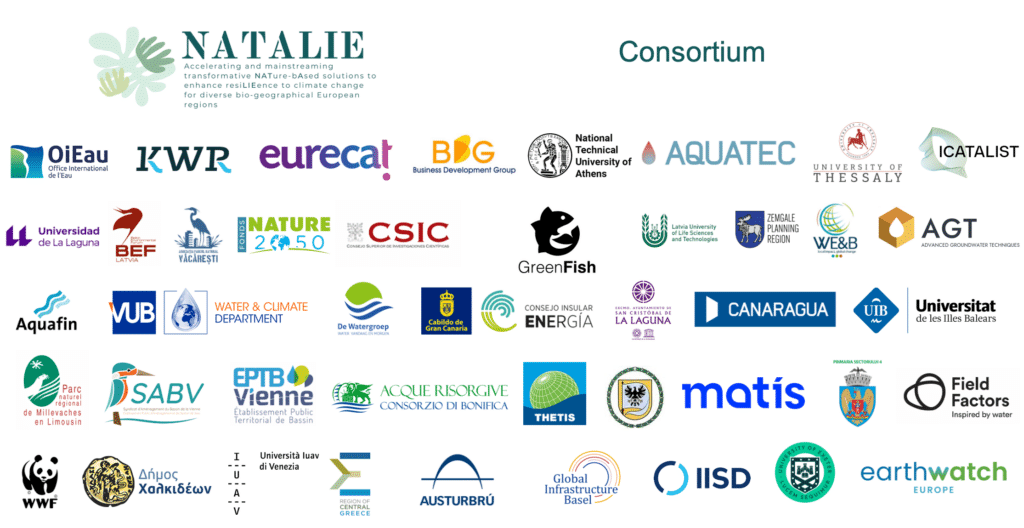
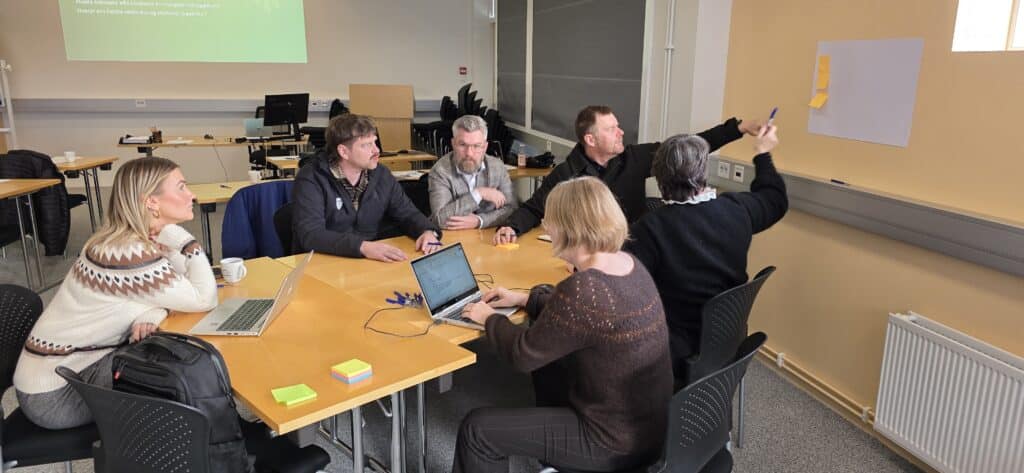
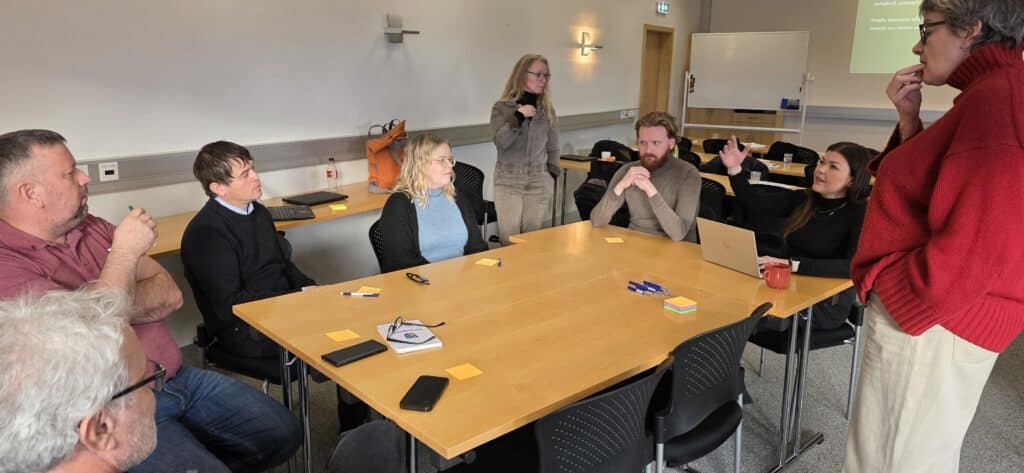

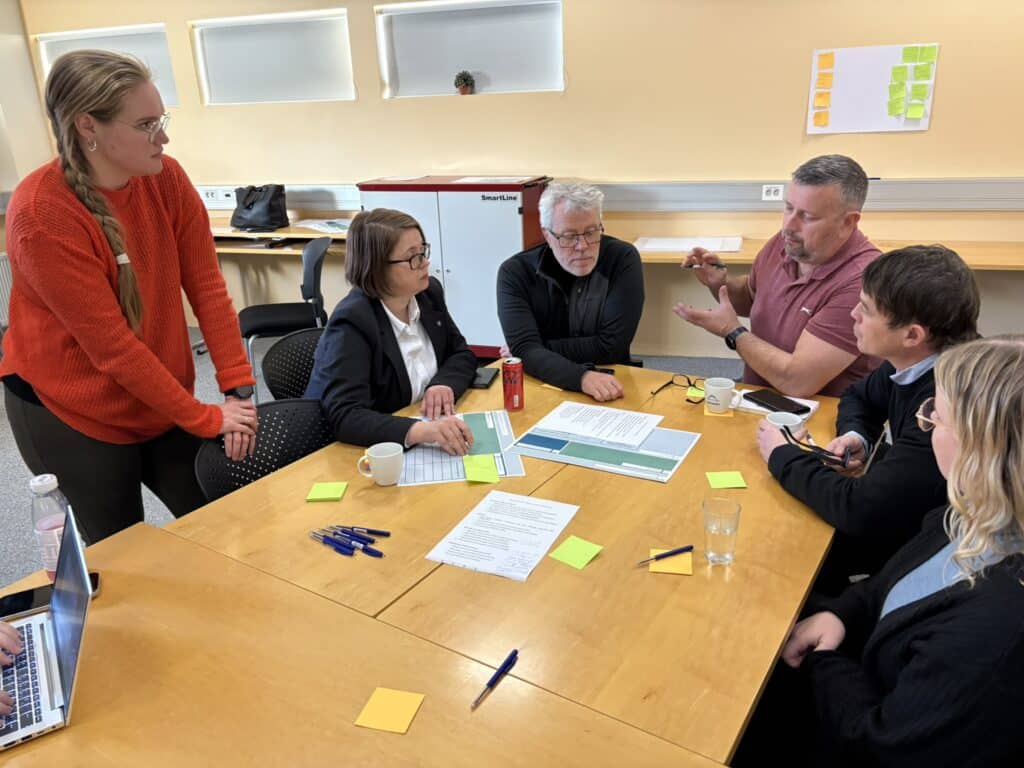
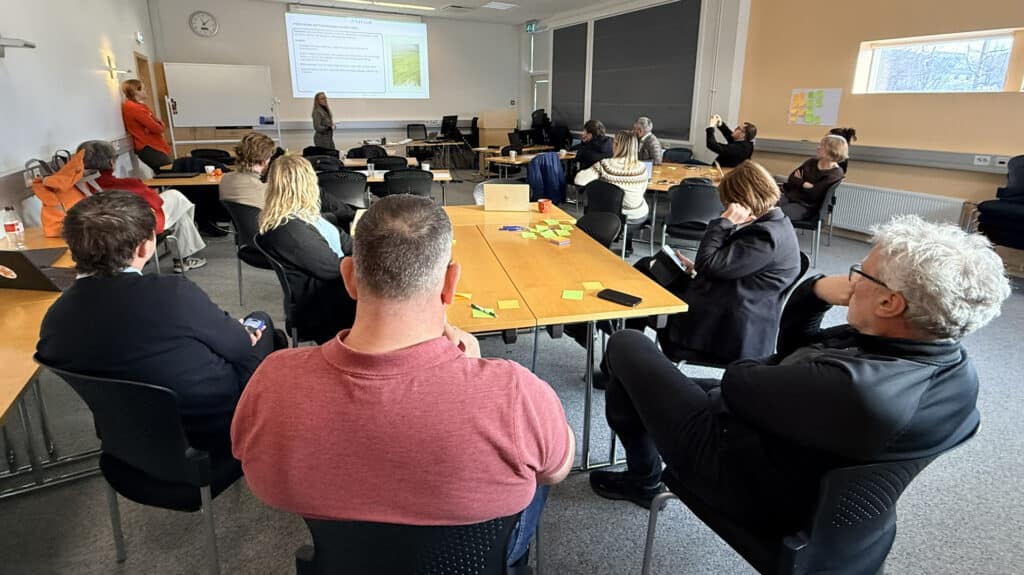



Haldið var áfram að kanna fitusprengingu og áhrif hennar á bragðgæði lambakjöts á Íslandi. Þróaður var myndakvarði til að meta fitusprengingu í lambavöðvum og hann notaður við mat á um 500 kældum skrokkum frá þremur ræktunarbúum í sláturhúsum haustið 2023. Einnig voru tekin sýni af hryggvöðvum og innanvöðvafita mæld í þeim með NIR-mælingu. Tekin var saman skýrsla um hraðvirkar aðferðir við mælingar á innanvöðvafitu í lambavöðvum. Skynmat var gert á 52 sýnum af lambahryggvöðva til að kanna áhrif fituflokka (2–,2 og 3+ samkvæmt reglum Evrópusambandsins) og kyns á bragð, lykt og áferð.
Erfitt var vegna lítillar fitusprengingar að nota myndakvarða til að meta fitusprengingu í hryggvöðvum lamba. Fylgni á milli sjónmats og NIR mælinga var of lítil til að hægt sé að nota sjónmatið með áreiðanlegum hætti. Aðhvarfslíking var þróuð fyrir NIR mælingu sem mældi fitu með sæmilegri nákvæmni. Í sumum tilfellum en ekki öllum var munur á milli hrútlamba og gimbrarlamba í fitu í hryggvöðva. Meðalfita í hryggvöðva lamba eftir bæjum var 2,0%, 2,3% og 3.0%. Fita í hryggvöðva var á bilinu 0,4 – 8,0 % þ.e. töluverður breytileiki og hærri gildi en í fyrri mælingum. Munur á innanvöðvafitu á milli gimbrarlamda og hrútlamba var enginn á einu búi (2,01% og 1,99%) og seinni slátrun á öðru búi ( 3,11% á móti 3,07%) en töluverður á tveimur búum ( 2,94% á móti 1,99% og 2,90% á móti 2,10%).
Hryggvöðvar lamba úr fituflokki 3+ höfðu tilhneigingu til að vera örlítið mýkri, safaríkari og meyrari en kjöt af lömbum úr fituflokkum 2 og ‑2. Niðurstaðan var ekki eins afgerandi niðurstaða og í svipaðri tilraun sem gerð var árið 2022. Kjöt af hrútlömbum hafði meiri fitulykt og þyngri lykt, og hafði einnig tilhneigingu til að hafa meiri súra lykt, meira fitu- og lifrarbragð, og vera þurrara en kjöt af gimbrarlömbum.
Upplýsingar um fitusprengingu í íslensku lambakjöti eru enn of takmarkaðar til að fá svör við því hvort taka eigi fitusprengingu inn í kynbótamarkmið. Ávinningur verkefnisins er fyrst og fremst reynsla, þekking og upplýsingar sem nýtast við frekari rannsóknir varðandi ræktunarstarf, vinnslu lambaskrokka og markaðssetningu lambakjöts.
_____
Four-point visual grading scale was used to evaluate marbling in loin muscles (m.l. dorsi) in chilled carcases of 500 lambs from three breeding farms. Correlation with NIR analyses of intramuscular fat was low. More training and development of NIR methodology is needed for future research and breeding for higher intramuscular fat. Analysed intramuscular fat was between 0,4 and 8% and the average for the three farms was 2,0%, 2,3% and 3% respectively with great variation within each group. So, there may be a potential for genetic selection for higher intramuscular fat.
The influence of EUROP carcass fat grade (2–, 2 and 3+) of slaughter lambs on eating quality of loin muscles (m l.dorsi) was studied. Samples of loin muscles of carcases of ewe and ram lambs were evaluated using descriptive sensory analysis to determine eating quality. No differences in eating quality attributes between fat grades were observed but meat from grade 3+ had the tendency to be a little juicier, softer and more tender.
The first aim of the project was to gather information and develop methodology and gain experience to be able to the answer if intramuscular fat should be a breeding goal to improve eating quality of Icelandic lamb meat. That is too early to say. Much more work needs to be done, and information are still too limited to say so.
Meat from ram lambs had stronger odour (fatty and heavy) the meat from ewe lambs. No gender differences in intramuscular fat were observed in between ewe lambs and ram lambs (2,01% vs 1,99%) from two farms (2,01% versus1,99% 3,11% versus 3,07%) while a difference was observed at two farms ( 2,94% versus 1,99% and 2,90% versus 2,10%).
The second aim was to determine if by implementing subgroups of fat grades of carcases the meat could be more separated into quality groups for processing and marketing purposes. About 85% of the lamb carcases produced in Iceland are within main fat groups 2 and 3. Subgroup 3+ might be 15% of the total production. Meat from that group had tendency to be juicier and more tender supporting results from the year 2022.
View report
This report is closed.







